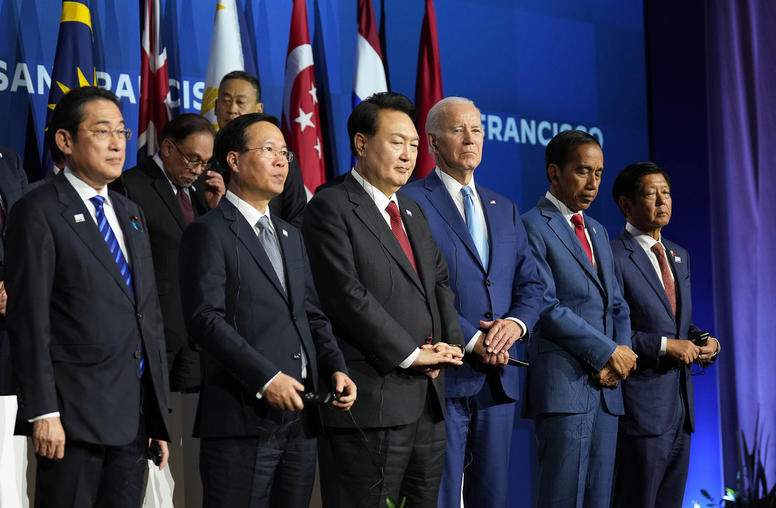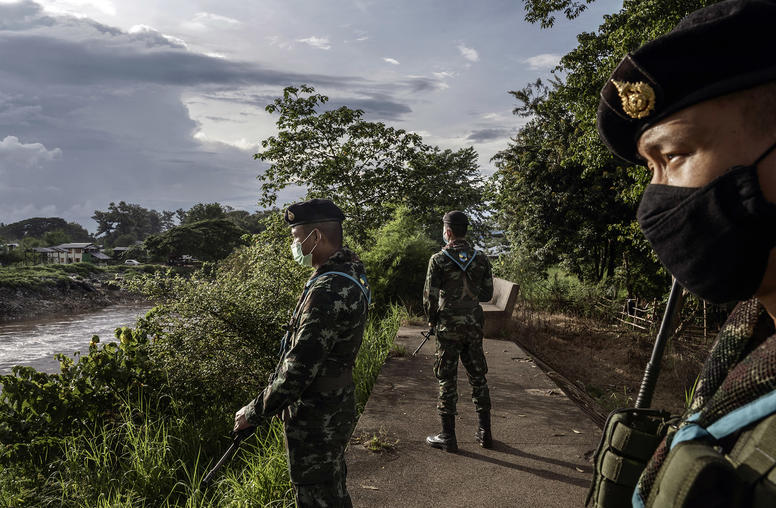With TikTok and Harry Potter, Thai Youth Protesters Usher in New Era of Politics
Through creative nonviolent action, demonstrators have confounded the government and its efforts to quash dissent.
In recent months a largely leaderless movement comprised of young people has ushered in a new phase in Thailand’s political struggle, successfully putting the government and monarchy on the back foot. While key demands—a new election, a new constitution, monarchal reform—have not been met, protesters have pledged to return to the streets in 2021 in greater numbers after taking an end-of-year pause. The movement has already been more successful than past iterations of protests in some ways, most notably by normalizing public discussion of the previously taboo but fundamental subject of the role of the monarchy in politics. Meanwhile, the protesters’ youth and creative tactics have put the government in an unprecedented quandary about how to respond.

Thailand’s Turbulent Politics
Thai politics had seemingly seen it all since the early 2000s when political gridlock began to cripple the Kingdom: two military coups, prime ministers removed on spurious legal grounds, protesters shutting down one of Asia’s key economic centers, Asian leaders fleeing a summit in helicopters, a royal succession elevating an enigmatic new king, with at least 100 peaceful protesters and dissidents killed along the way. Together, this rollercoaster has been a contest over whether Bangkok’s traditional power brokers—a loose alliance between the monarchy, military, and big business—will continue to wield power in the Kingdom, or whether a long-silent majority would accrue power.
Despite protesters' ability to move the needle in ways previously unseen, conservative elites have managed to prevail through the use of a wide range of repressive tactics, and today a retired Army general remains prime minister more than six years after leading a coup, the monarchy is more involved in politics now than in generations, and a new political party that convincingly displayed the younger generation’s widespread dissatisfaction with the country’s politics has been banned.
Thailand’s Protesters Rise
The movement began over the past summer as disparate, independent protests demanding reforms ranging from ending gender discriminatory practices on high school and university campuses to accountability for the violent disappearances of previously outspoken Thai dissidents. On August 15, the protests entered a new phase when approximately 10,000 students converged on Thammasat University with a list of bold demands, including some related to the monarchy. From there, these protests quickly grew. On October 15, tens of thousands gathered in Bangkok, defying an emergency decree banning the gathering of more than four people to call for the release of 20 activist leaders who had been arrested.
Over months of continual protest, the movement’s message evolved into a greater vision for a more democratic Thailand with calls to action evoking Thailand’s 1932 revolution. In 1932, popular mobilization removed Thailand’s last absolute monarch, King Prajadhipok, from power, transitioning Thailand to a constitutional monarchy, and broadly instilled in the national political psyche the idea that the country belongs to the people, not the monarchy.
The protesters’ youth and lack of connection to tarnished political leaders such as former Prime Minister Thaksin Shinawatra, have proven difficult for the government to manage, with security forces exercising some degree of restraint to date. Perhaps more importantly, it has been the protesters' tactical ingenuity amid a minefield of repressive laws that has enabled the movement to blossom. These laws have been used to imprison alleged dissidents with increasing frequency and increasing sentence length since the 2014 coup. Thai authorities apply these laws aggressively, making even a small act of hitting “Like” on a dissenting Facebook post a punishable offense. Criticism of the monarchy is even more dangerous, given draconian laws that make defamation punishable by up to 15 years in prison. Thai authorities have liberally applied these laws in recent weeks, with 40 protesters arrested so far. Yet the protesters have largely been undaunted and have demonstrated willingness to face arrest
To make matters worse for the protesters, COVID-19 has posed an additional risk for convening large crowds. A new second wave currently afflicting Thailand has offered additional cause for the government to unilaterally ban all protest gatherings at the start of the new year. Protesters have met this by strengthening their ubiquitous presence online.
Creative Cultural Tactics
Much of the protest movement’s staying power amid this restrictive environment can be ascribed to the protesters’ innovative tactics, particularly on social media and the use of popular culture. Where speaking a word against the monarchy was taboo, people openly draw graffiti of the king. As COVID-19 cases rise, protesters have taken to organizing online through social media. Prominent activist-scholar Pavin Chachavalpongpun, for example, has garnered thousands of followers with compelling Facebook testimonies and viral satirical TikTok videos calling for reform.
When protesters seek to make their voices heard in-person, a decentralized structure of loosely connected networks has enabled them to mobilize quickly in flash-mob like fashion across the country, similar to the amorphous tactics of the Hong Kong protesters who stress the idea to “be water” and remain an intractable force. The protesters have also forged online solidarity with like-minded protesters in Hong Kong and Taiwan, dubbed the Milk Tea Alliance. As the Thai government returns to the familiar instruments of water cannons, police violence, and limiting freedom of speech, this generation of protesters has managed to stay a step ahead of the political establishment’s traditional means of cracking down on dissent.
One prominent tactic has been the adaption of pop culture as symbols of protest. For example, while legally restricted from criticizing the monarchy, protesters gathered in a rally dressed as characters from “Harry Potter” to speak out against “You-Know-Who,” comparing the monarchy to the fictitious villain so feared that his name was forbidden to be spoken. Similarly, protesters often raise a three-finger salute, an anti-authoritarian gesture drawn from the popular “Hunger Games” franchise, which depicted a story of a futuristic authoritarian society plagued by vast economic inequality. Although these references initially read as humorous signals of a younger generation of protesters, such comparisons illustrate a common understanding of what limiting freedom of speech means for a shrinking democracy. Fundamentally, “Harry Potter” and the “Hunger Games” are stories of young people fighting oppressive forces for a more equitable world. In an environment where dissent can be deadly, these pop culture references draw a parallel without ever naming the opposition.
However, signaling a pop culture reference in place of explicit dissent has not always made acts of protest any safer. In mid-October two protesters, Bunkueanun Paothong and Aekachai Hongkangwan, waved the three-finger salute at the royal motorcade and later were arrested and charged with violence against the queen. Meanwhile, small acts of dissent are increasingly met with disproportionate force. The emergence of rubber ducks as the latest symbol of the protest movement captures this idea well; protesters bring giant rubber ducks, comically nominated as “the protectors” of the movement, to the frontlines to face the threat of water cannons and tear gas. The image of rubber ducks against water cannons and tear gas satirizes the lack of political agency that ordinary people of Thailand feel against the vast power of the monarchy and the military.
U.S. Interests
The United States has a stake in the outcome on several fronts. Thailand stands as a bellwether in a region where democratic governance is under siege and China seeks to shape norms around governance. Internationally, a stable and outward-looking Thailand has the potential to play a leading role within the Association of Southeast Asian Nations and as a hub for connectivity in mainland Southeast Asia, which both contribute to a more cohesive and resilient region in the face of growing Chinese influence.
Despite challenges, Thailand remains one of five U.S treaty allies in the Asia-Pacific region, providing a foundation for deep security cooperation including U.S. access to airfields that enable global mobility for U.S. forces, cooperation the U.S. government will seek to preserve regardless of Thailand’s political trajectory. Together, these factors likely point to a cautious approach to the protest movement by the incoming U.S. administration.
What’s Ahead?
Despite increasingly aggressive efforts to shut down the protests, the protesters show no signs of stopping and have pledged to return to the streets in the new year with more force, although a surge in COVID-19 will make for an even more challenging environment in the near-term. While speculation of a future military crackdown looms, recent efforts by King Vajiralongkorn to enhance his public image offers a sliver of hope engagement, in clear recognition that a harsh crackdown against students would further endanger the monarchy in the realm of public opinion. When asked about the protesters during his first public interview in years, he offered “Thailand is the land of compromise,” suggesting the possibility of concessions. Yet how this famously unpredictable king will ultimately navigate the first political crisis of his reign remains unclear, with the only certainty being that the King of Thailand has become more central to the political life of the Kingdom than at any point since the 1932 revolution. For now, although the future of the movement remains unclear, it is clear a new generation is bringing Thailand’s politics into a new era.
Gabriela Sagun is a senior program assistant for the Burma program at the U.S. Institute of Peace.



